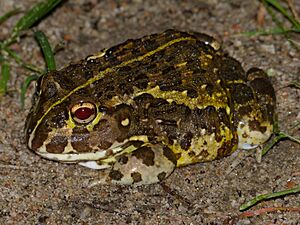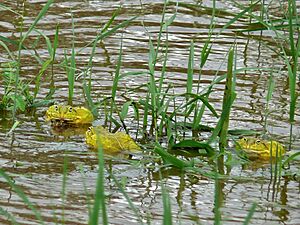Edible bullfrog facts for kids
Quick facts for kids Edible bullfrog |
|
|---|---|
 |
|
 |
|
| Conservation status | |
| Scientific classification | |
| Synonyms | |
|
The edible bullfrog (Pyxicephalus edulis), also known as the pixie frog or Peter's bullfrog, is a large frog species found in Africa. It belongs to the Pyxicephalidae family, which includes other large frogs.
Contents
What Does the Edible Bullfrog Look Like?
Edible bullfrogs are big frogs. Males usually grow to about 8.3–12 cm (3.3–4.7 in) long from their snout to their vent. Females are a bit smaller, reaching 8.5–11 cm (3.3–4.3 in). Very large males can even be 13.8 cm (5.4 in) long.
Females are much lighter than males, often weighing only half as much. These frogs have a wide mouth with two tooth-like bumps on their lower jaw that point upwards. Their skin has small, rounded bumps.
Young frogs look plump and sturdy. As they grow, they become flatter. Their eyes also become more central and stick out a lot. They have a clear, large, oval-shaped eardrum, called a tympanum. Their front feet are not webbed, but their back feet are.
Colors and Markings
Adult edible bullfrogs are usually yellow-green to olive-green. Males tend to be greener. Females are more olive-brown and sometimes have a pale stripe down their back. They might also have light lines on their bumps.
Young frogs often have a bright green stripe along their back. Their dark green skin has gold-brown speckles and black marks. Their lips and feet can have black bars. The bottom half of their body is white or cream, but males have a dark yellow throat.
What Sound Does the Edible Bullfrog Make?
The edible bullfrog makes a short, deep "whoop" sound. This call lasts for about 0.11 to 0.29 seconds. They make these calls at different times, not in a regular pattern.
Where Do Edible Bullfrogs Live?
You can find edible bullfrogs in many African countries. These include Angola, Benin, Botswana, Burkina Faso, Chad, Kenya, Malawi, Mali, Mauritania, Mozambique, Nigeria, Tanzania, Zambia, and Zimbabwe. Sometimes, people confuse them with similar frog species, like the African bullfrog (Pyxicephalus adspersus).
What Kind of Home Do They Like?
Edible bullfrogs prefer flooded grasslands. In some areas, they like open marshy places. They can also be found in flooded meadows and ditches. These frogs seem to like areas with clay or sand in the soil.
Life Cycle and Habits of the Edible Bullfrog
Edible bullfrogs spend most of the year, about 10 months, sleeping underground. This special sleep is called aestivation. They only come out to breed when there's a lot of rain, usually more than 70 mm (2.8 in), in a short time.
Breeding Behavior
When it rains enough, male edible bullfrogs start calling from flooded grasslands. They also call from small, temporary pools like roadside ditches, especially where the water is shallow (less than 200 mm (7.9 in) deep). Breeding usually happens during the day.
Males gather in loose groups in the shallow water. Each group has a dominant male who will chase and try to move other males that come too close. Sometimes, these fights can be very intense. Females move freely between these male groups, and males will follow them.
Once a male and female pair up, they usually aren't bothered by other frogs. The female starts laying eggs soon after the male holds onto her. The eggs are laid in the shallow water. Males call from the water with their heads and vocal sacs above the surface. Their deep calls make ripples in the water.
What Do They Eat?
Edible bullfrogs mainly eat insects. Their diet often includes beetles (Coleoptera) and grasshoppers (Orthoptera). They also eat termites (Isoptera), millipedes (Diplopoda), ants (Hymenoptera), and spiders. Sometimes, they might accidentally swallow plants while catching their prey.
Who Hunts Them?
When frogs gather to breed, they attract many bird predators. These birds include the yellow-billed kite (Milvus aegyptius), marabou stork (Leptoptilos crumeniferus), saddle-billed stork (Ephippiorhynchus senegalensis), intermediate egret (Mesophoyx intermedia), grey heron (Ardea cinerea), and black-headed heron (Ardea melanocephala).
Sometimes, edible bullfrogs will lunge at water birds that get too close. This might be the males protecting their breeding areas. After the eggs hatch, the males guard the tadpoles. If their pool starts to dry out, the males might even dig channels to help the tadpoles move to deeper water.
How Do Humans Use Edible Bullfrogs?
In some places, people eat edible bullfrogs. They are also sometimes sold as pets around the world.
Protecting the Edible Bullfrog
One of the biggest threats to edible bullfrog populations is people collecting them for food. While they are sometimes sold as pets, this usually doesn't harm the species much. In some areas, like western Tanzania, their homes are being lost. This happens when miombo woodlands are turned into farmland. This habitat loss, combined with too many frogs being collected, can cause their numbers to drop.
Images for kids




